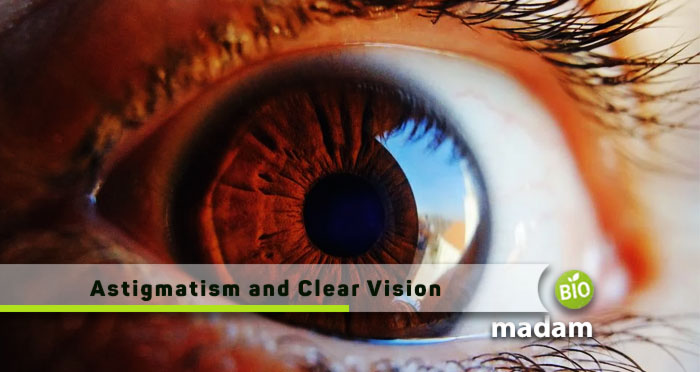Recently updated on March 14th, 2023 at 07:13 am
Astigmatism is a term you’ve probably come across every time you read about eye vision problems. This is one of the most common eye problems, and one in every three people, from newborns to seniors, have it to some degree.
In this post, we answer vital astigmatism-related questions that your eye doctor may not have the time to answer: what is astigmatism, and should you be worried if you have it? Can astigmatism get worse? How is astigmatism corrected?
Astigmatism in Simple Terms
Astigmatism is a condition whereby the structures of the eye, particularly the cornea and the lens, are not completely round. Instead, they are warped. This imperfection makes it difficult for the eye to refract light precisely on the retina, leading to blurry and distorted vision.
A healthy eye has a perfectly round shape like a tennis ball. But an eye with astigmatism is shaped like a rugby ball- albeit not as dramatic.
When the eye is healthy and perfectly round, light rays through the cornea and lens converge into a single focus point on the retina for processing. On the other hand, an eye with astigmatism creates two focal points on the retina, resulting in blurry or unclear images.
Essentially, astigmatism is not an eye disease but a condition that affects how the eye focuses the light. The degree of blurriness will vary between patients depending on the level of imperfection on the cornea or the lens.
Types of Astigmatism
One way of classifying astigmatism is by its source: cornea or lens. Distortion of the corneal surfaces leads to corneal astigmatism, while distortion of the lens curvature causes lenticular astigmatism.
Corneal astigmatism is more common than lenticular astigmatism. But patients experience blurry or distorted vision regardless of the part of the eye affected.
Astigmatism can also be classified based on the principal meridians of the eyes. Considering the front of the eye as a clock face, there would be two lines: one running from six to twelve and another connecting three and nine. When either of these meridians is steeper than the second, it has a stronger focusing power. This leads to two different points of focus on the retina.

There are three types of astigmatism based on the principal meridians of the eyes:
Myopic Astigmatism: this occurs when one or both principal meridians focus light rays in front of the retina (nearsightedness).
Hyperopic Astigmatism: this is the opposite of myopic astigmatism. Hyperopic astigmatism occurs when one or both meridians of the eye focus light behind the retina (farsightedness).
Mixed Astigmatism: mixed astigmatism is a combination of myopic and hyperopic astigmatism. In this condition, one principal meridian is myopic (focuses light in front of the retina) while the other is hyperopic (focuses light beyond the retina).
Causes of Astigmatism
Astigmatism is thought to be hereditary, so if your parents have astigmatism, there are high chances that you have it too. Research also shows that children born preterm are at a higher risk of astigmatism and other eye conditions. Astigmatism may also develop following an eye injury or surgical operation that distorts the corneal curvature. But while it only gets worse with age, astigmatism does not lead to blindness.
Common Symptoms of Astigmatism
It’s possible to live with astigmatism and not even realize it. Here are the most common symptoms of astigmatism to be on the lookout for:
- Squinting
- Difficulty with night vision
- Blurred or vision
- Eyestrain
- Eye irritation
- Headaches
Astigmatism Treatment Options
Astigmatism- like any other eye condition- sounds scary. But the good news is that astigmatism can be corrected using eye contacts, such as Acuvue for astigmatism daily lenses, eyeglasses, and even surgery.
Contact Lenses for Astigmatism
Contact lenses are increasingly becoming the most preferred method of correcting astigmatism. Unlike eyeglasses, contact lenses for astigmatism offer a more natural vision and don’t have anything to block what you see. Also, because contact lenses sit right on the eyeball, they are ideal if you live an active lifestyle.
There are three major types of contact lenses that help with astigmatism.
Toric are the most popular contact lenses for astigmatism because they are designed purposely to help fix this condition. While regular contacts have a spherical surface, torics resemble a slice from the side of a donut. Their unique shape helps in refracting incoming light rays in a specific direction, thus compensating for the distorted shape of the cornea or eye lens.
Rapid Gas Permeable (RGP) contact lenses- RGP contacts are hard lenses with a spherical or toric design. These lenses are more rigid than alternatives and are, therefore, able to easily maintain their position on the eye’s surface. The fact that they are breathable also means that your eyes breathe better.
Hybrid contact lenses – combine the strengths of torics and Rapid Gas Permeable contacts to give you lenses that improve your visual acuity (VA) while being comfortable to wear.
Glasses for Astigmatism
Astigmatism glasses are a more affordable alternative to contact lenses. Glasses for astigmatism have a special cylindrical lens that optimizes how light rays pass through the cornea and get focused on the retina.
When it comes to buying glasses for astigmatism, it’s advisable to go with flatter frames that rest comfortably on the bridge of your nose. This ensures that the lenses are always in proper alignment with your eyes for sharp images and clear vision.
Laser Treatment for Astigmatism

LASIK (abbreviation for Laser-assisted in situ keratomileusis) is the most common type of laser refractive surgery for astigmatism. The eye surgeon uses a cutting laser to reshape the dome-like cornea into a more spherical shape.
LASIK eye surgery is relatively safe. However, this is a complex procedure often left to the most experienced eye surgeons. Though rare, the risk of a complication that affects your vision permanently exists.
Additionally, there’s a likelihood of losing your best correctable vision using contact lenses and eyeglasses. The high cost of LASIK eye surgery, coupled with the fact that most insurance plans do not cover it, is another reason most people shy away from this treatment option.
Importantly, note that not all astigmatism patients are eligible for LASIK. For instance, you may not be a good candidate if you have a high degree of astigmatism, myopia, or hyperopia.
Also, you may not qualify for LASIK if you have an unstable vision, unresolved vision problems (for instance, dry eyes and scarring), and other underlying health diseases or disorders, such as autoimmune disorders. A laser eye surgery will run some tests to determine whether you qualify for LASIK.

Hi, they call me Jenna, and I am also known for achieving a gold medal during my Ph.D. in science life. I always had a dream to educate people through my utmost writing hobby. So, I chose this blogging path, and Biomadam gave me this opportunity to present for them. I now stand to entertain you. Continue reading my articles & discuss if you’ve any confusion through the comment section below.

